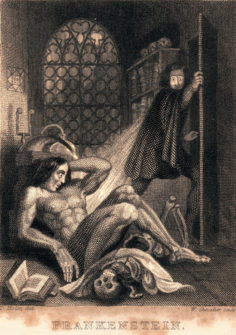
On the morning of November 26th, 2018, I met with sixteen Saint Anselm College first year students to discuss Mary Shelley’s Frankenstein. The timing could not have been better to read a two-hundred year old text. That morning the news had broken that a Chinese scientist, He Jiankui, announced two live births from germline edited embryos. Dr. Jiankui used the CRISPR-Cas9 gene editing tool that Natalie Kofler discusses in her essay in this Contending Modernities series. On that cold wintery morning, the book seemed less like early 19th century science fiction and more like a cautionary tale for our time.
During the seminar we discussed how Victor Frankenstein’s unnamed creature destroyed Victor’s life, whether Victor or the creature (or no one) was the sympathetic figure in the story, and whether or not Victor should have acceded to the creature’s demands to create a female companion. We also took up questions related to having children and the obligations of creators to creatures. Given the news that had broken that morning, these questions took on new urgency as we debated the prospects of designing our own children.
The students noted that Victor immediately rejected the creature after bringing him to life. Some defended this response. These students argued that the creature failed to meet Victor’s expectations; he was too gruesome and ugly to be lovable.

These students applied what I call the logic of creation to the case. The logic goes like this. Persons create things for a certain end. Chairs, for example, are created for sitting. All acceptance and rejection of the creation is predicated upon whether or not it fulfills its intended end. When the creation meets its goal, it is accepted. When it does not, it can be rejected and destroyed. And so, we keep functional chairs and trash the three-legged kind. Such rejection and destruction are permissible because the creation is owned by the creator. John Locke famously argued that goods become private property when a person combines his labor with what he is creating. The fruits of one’s labor are privately owned by the laborer. Because the monster was Victor’s creation, it was not unjust for Victor to drive him away. The monster was a “broken” creation, a three-legged chair if you will, worthy to share in such a chair’s fate.
Others sympathized with the creature. They argued that only non-personal creations, such as chairs, should be created. While the word “begetting” never made its way into the conversation, their argument suggested that personal creatures should be begotten, never made.
As a theological ethicist, I heard what I call the “logic of begetting” in their arguments. Christianity’s central dogmatic creed, for instance, suggests that the logic of begetting is different than that of creating. There we find that the second person of the Trinity, the Son of God incarnate in the person of Jesus Christ, “was begotten, not made.” Human parents image God insofar as they beget, but do not create or design, their children. The process of begetting is mysterious, and retains a spirit of openness to whomever the child is because the child is not a manufactured product. Children emerge as gifts to parents. Gifts, Pope Benedict argued in Caritas in veritate, are gratuitously given, and are freely accepted. Because gifts are gratuitously given by the giver, they should never be requested by the recipient. Christians throughout the world have managed to misunderstand this aspect of gifts through the creation of gift “wish lists” regarding Christmas and weddings. How many times have we requested a gift, only to be disappointed to not receive exactly what we wanted? In those moments we evaluate the gift before fully accepting it. At times, we ask the gift giver to exchange the gift for something “better.” In these instances the experience of gifting has been lost. Compare those experiences with the times in which one has been surprised to receive a gift at all. In these moments, moments in which there is no expectation of or request for a gift, we are genuinely moved by the gift, and grow closer to the gift giver as a result. Here we experience the gratuitousness of a true gift and respond with appropriate gratitude for the gift, no matter how small it may be. In these instances we immediately accept the gift without first evaluating the gift’s merits or flaws.

Children should be received in the latter manner, not the former. Parents should freely accept and love their children unconditionally. However, if we design our children, if we “ask” for certain kinds of children, we move away from understanding and accepting our children as gifts. Our acceptance of them becomes conditioned on whether or not they fulfilled the end we intended in creating them.
Although we may be able to edit out the genes at the germline level that code for diseases such as Tay Sachs or Huntington’s, it would be immoral to do so. Germline editing (whether therapeutic or for purposes of enhancement) is morally wrong because it changes the relationship of parents and children from one of begetter-begotten to creator-creature. Frankenstein vividly depicts the dangers of such a relationship. Such a change harms the relationship of parents and children, rendering it more difficult for parents to unconditionally accept and love their children.
The scholars on the “Out of the Lab” podcast repeatedly queried the existence of universal moral norms to guide a cross-cultural ethical analysis of germline editing. I believe that the logic of begetting/gifting is the best candidate for a universal moral norm to guide this analysis. While I have produced this argument from within the Christian tradition, one does not have to be Christian to believe that children should be begotten and should be accepted for who they are, and not who the parents would like the child to be.
Recall that the students who objected to Victor’s actions did not argue that he usurped the role of God, as many Christians have argued regarding gene editing. Nor did they channel Maura Ryan’s important approach in the “Out of the Lab” podcast, where she suggested that the debate ought to consider possible harms to the common good. Their argument did not emerge from religious principles. Instead, these students drew upon a normative account of the relation of parents and children. This account emerged inductively, from the experience of being a child and from the experience of other children. Personal and collective experience shows us that children rightly desire to be received and accepted by their parents as gifts, regardless of their abilities or genetic makeup.
Suggested Further Reading:
Michael Sandel, The Case Against Perfection: Ethics in the Age of Genetic Engineering (Cambridge, MA: Belknap Press, 2009).
Congregation For the Doctrine of the Faith, “Instruction Dignitas Personae on Certain Bioethical Questions”
Pope Benedict XVI, Caritas in veritate

